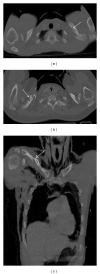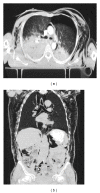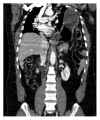Multidetector computer tomography: evaluation of blunt chest trauma in adults
- PMID: 25295188
- PMCID: PMC4175749
- DOI: 10.1155/2014/864369
Multidetector computer tomography: evaluation of blunt chest trauma in adults
Abstract
Imaging plays an essential part of chest trauma care. By definition, the employed imaging technique in the emergency setting should reach the correct diagnosis as fast as possible. In severe chest blunt trauma, multidetector computer tomography (MDCT) has become part of the initial workup, mainly due to its high sensitivity and diagnostic accuracy of the technique for the detection and characterization of thoracic injuries and also due to its wide availability in tertiary care centers. The aim of this paper is to review and illustrate a spectrum of characteristic MDCT findings of blunt traumatic injuries of the chest including the lungs, mediastinum, pleural space, and chest wall.
Figures



















Similar articles
-
Blunt traumatic injuries of the lung parenchyma, pleura, thoracic wall, and intrathoracic airways: multidetector computer tomography imaging findings.Emerg Radiol. 2007 Oct;14(5):297-310. doi: 10.1007/s10140-007-0651-8. Epub 2007 Jul 11. Emerg Radiol. 2007. PMID: 17623115 Review.
-
Imaging of Combat-Related Thoracic Trauma - Blunt Trauma and Blast Lung Injury.Mil Med. 2018 Mar 1;183(3-4):e89-e96. doi: 10.1093/milmed/usx033. Mil Med. 2018. PMID: 29514343
-
Thoracic wall trauma-misdiagnosed lesions on radiographs and usefulness of ultrasound, multidetector computed tomography and magnetic resonance imaging.Quant Imaging Med Surg. 2017 Aug;7(4):384-397. doi: 10.21037/qims.2017.08.02. Quant Imaging Med Surg. 2017. PMID: 28932697 Free PMC article. Review.
-
Chest wall, lung, and pleural space trauma.Radiol Clin North Am. 2006 Mar;44(2):213-24, viii. doi: 10.1016/j.rcl.2005.10.006. Radiol Clin North Am. 2006. PMID: 16500204 Review.
-
[A contribution of multidetector computed tomography to indications for chest wall stabilisation in multiple rib fractures].Acta Chir Orthop Traumatol Cech. 2011;78(3):258-61. Acta Chir Orthop Traumatol Cech. 2011. PMID: 21729644 Czech.
Cited by
-
Diagnostic accuracy of a commercially available deep-learning algorithm in supine chest radiographs following trauma.Br J Radiol. 2022 Jun 1;95(1134):20210979. doi: 10.1259/bjr.20210979. Epub 2022 Mar 24. Br J Radiol. 2022. PMID: 35271382 Free PMC article.
-
Posterior membranous tracheal injury during mckeown oesophagectomy. A case report with literature review.Front Oncol. 2025 May 9;15:1560437. doi: 10.3389/fonc.2025.1560437. eCollection 2025. Front Oncol. 2025. PMID: 40416879 Free PMC article.
-
Dual-phase CT for the assessment of acute vascular injuries in high-energy blunt trauma: the imaging findings and management implications.Br J Radiol. 2016;89(1061):20150952. doi: 10.1259/bjr.20150952. Epub 2016 Feb 17. Br J Radiol. 2016. PMID: 26882960 Free PMC article. Review.
-
Clinical Significance and Prognostic Implications of Quantifying Pulmonary Contusion Volume in Patients with Blunt Chest Trauma.Med Sci Monit. 2017 Jul 26;23:3641-3648. doi: 10.12659/msm.902197. Med Sci Monit. 2017. PMID: 28746303 Free PMC article.
-
A possible role of e-FAST in the hemodynamically stable polytrauma patient: results of a single trauma center preliminary restrospective study.J Ultrasound. 2025 Mar;28(1):75-79. doi: 10.1007/s40477-024-00962-0. Epub 2024 Nov 9. J Ultrasound. 2025. PMID: 39521752
References
-
- Mullinix AJ, Foley WD. Multidetector computed tomography and blunt thoracoabdominal trauma. Journal of Computer Assisted Tomography. 2004;28(supplement 1):S20–S27. - PubMed
-
- Miller LA. Chest wall, lung, and pleural space trauma. Radiologic Clinics of North America. 2006;44(2):213–224. - PubMed
-
- Scaglione M, Pinto A, Pedrosa I, Sparano A, Romano L. Multi-detector row computed tomography and blunt chest trauma. European Journal of Radiology. 2008;65(3):377–388. - PubMed
-
- Chardoli M, Hasan-Ghaliaee T, Akbari H, Rahimi-Movaghar V. Accuracy of chest radiography versus chest computed tomography in hemodynamically stable patients with blunt chest trauma. Chinese Journal of Traumatology. 2013;16(6):351–354. - PubMed
Publication types
LinkOut - more resources
Full Text Sources
Other Literature Sources

